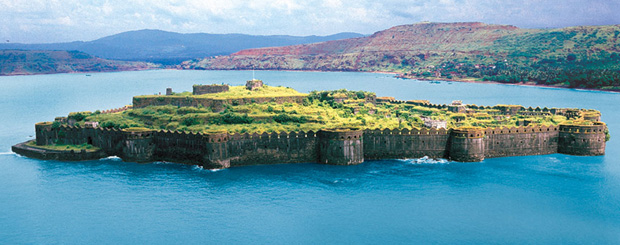Janjira Fort | The Fighter Fort
 |
| The Janjira Fort |
Mythology Cafe's this post is about a historical architectural site which was built, destroyed, rebuilt, and attacked but is still standing with all of its glory - The JANJIRA FORT. The word Janjira originated from the Arabic word Janzeera, which means 'an island'. It is also known as Janjira Jal-durg(Jal-durg means 'Sea Fort') and Murud - Janjira( concatenation of the Konkani and Arabic words for Island, "morod" and "jazeera").
Location - On an island on the Outer Coast of Murud, a small
town in Raigarh district of Maharashtra
Built in the 17th century, located on an island, standing with an impressive height of 40 feets and bounded by high walls is the Janjira Fort. Originally a small wooden structure used for defense against the pirates was transformed into this huge masterpiece by Malik Ambar, who was an Abssinian minister in the court of the Sultan of Ahmednagar, Sidi Sirul Khan, and with its construction is related a famous local legend.
 |
| Entrance to the Janjira Fort |
It is said that during its construction, the structure collapsed thrice. Sidi realized that he needs a sacrifice in order to completely built this Fort, so to protect his kingdom from any future enemy attacks he offered his 22 years old son to God.
The story may sound a bit superstitious but none of us can deny the fact that it worked and the fort is the living & still standing proof of it. Not only the fort is still standing in the middle of the sea, it has been listed in history that the fort was attacked many times by the Portuguese, British and the Marathas, but could not be conquered by any of the kings ruling the neighboring territories. Surprisingly, not even Shivaji could acquire it, despite 13 expeditions to conquer the fort. His son, Sambhaji, tried a unique approach to capture the fort: digging an underwater tunnel to enter. But he too failed in his attempt. Not to be deterred, Sambhaji constructed another fort just across the bay, called Kansa. Most of the earth that was dug up to build the tunnel was used in the making of this second fort, which was to be the base for future attacks on the sea fort of Janjira.
 |
| Arial view of Janjira Fort |
Spread over 22 acres the surrounding of the fort is full of coconut and betel nut trees. As we move towards the main entrance of this fort we come across stone carvings depicting six elephants trapped by a single tiger, it was made to represent the bravery of the Siddis.
 |
| Stone carving at the main entrance of the Fort |
There are several towers and turrets in the Janjira Fort, which are used for keeping guns and cannons. This fort had a total of 500 canons previously but now only a few of them exist. The fort has 23 huge bastions about 30-40 ft high, still intact. Amongst them are the three major cannons - ‘Kalal Bangadi', ‘Landa Kasam' and 'Chavi' built from five metals.
 |
| Kalal Bangadi canon |
. The main gate of the fort faces Rajapuri(a small village) on the shore is disguising, hidden and very huge. There is a small gate towards the open sea for to escape from the enemies. There are hidden passageways for emergencies.
This amazing 5-storied old palace is now in a ruined condition.
-XOXO
Ace
P.S. - The amazingly amazing Janjira Fort which tells the tales of its undefeatable past and how it stood strong against all enemies is now ruined by the hands of time and abandoned by us with nothing other than its loneliness & past voices. This fort is not just a historical architecture with stories but it is also giving us a message to stay strong. This fort has endured the lashes of the sea waves through ages and still stands strong. Just like Janjira we also have to stand strong through all the challenges life throws towards us like sea waves. Our history is trying so hard to support us, cant't we try a little?



Comments
Post a Comment